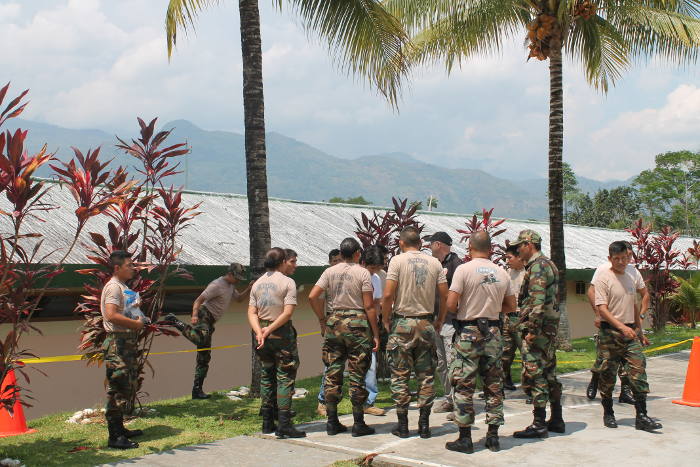-
02 August 2018
Category : Opinion
Are we already carrying out twinning projects in Latin America?
Gerard Muñoz reflects on the parallels between twinning projects and his experience in coordinating the project to fight against organised crime in Peru
 One of the project's activities in Peru
One of the project's activities in PeruAre we carrying out twinning between public administrations in Latin America, as the practice is known in the European Commission?
Formally no, but we have a series of very similar projects which could be considered as a pilot. Of course, these are an opportunity for the European Union to transmit their values and influence, especially in these times of turbulence and disagreement between the big blocks.
The negotiation of the new EU multi-annual financial framework 2021-2027 may be the time to introduce this topic into the cooperation agenda, with FIIAPP as a major player due to its extensive experience in this area.
Its technical characteristics make it a very useful development mechanism for middle-income countries in Latin America. Of course, it needs to be adapted to a very diverse reality at a sub-regional level, finding positive conditionalities regarding participation. We shall see.
What is twinning?
According to the European Commission, twinning is an EU mechanism for institutional cooperation between Public Administrations of EU Member States and beneficiary or partner countries, with the aim of achieving concrete mandatory operational results through peer to peer activities.
In countries in the process of joining the EU, such as Serbia or Macedonia, twinning between administrations focuses on providing support for the transposition, implementation and application of EU legislation, the famous acquis communautaire. This is to ensure that that when they become full members of the EU, they can operate normally following the European legal standards in sectors such as the administration of justice, security, transport, consumption, public health and intellectual property.
Since 2004, twinnings have also been implemented with some of the EU’s strategic partners such as the Ukraine and Turkey. Within this framework, the mechanism aims to improve the capacities of the public administrations in these countries by training their staff and supporting the reorganisation of their structure. It also supports the approximation of national laws, regulations and quality standards to those of the European Member States, within the framework of cooperation or partnership agreements signed with the EU.
A similar experience in Peru
In Peru over the last four years, FIIAPP has carried out activities similar to twinning through a project to fight organised crime, with similar aims. The project focused on components that correspond to the expected results. A series of activities were carried out that include workshops, training sessions, expert missions, study visits, internships and specialist technical advice.
Over this time, more than 2,600 Peruvian civil servants have been trained, 109 courses run in 64 different subjects, 34 technical assistances provided, and 13 internships organised in Europe. This has involved the mobilisation of more than 200 officials and employees in the public administrations of the Member States and an on-site team was responsible for the project.
The twinning is based on executive learning and sharing best practices, as has been the case in Peru in terms of intelligence, investigation and judicial processes. All this in order to improve the Peruvian State’s capacities in fighting drug trafficking and organised crime.
To give an example, after 4 years of work, the Peruvian authorities are obtaining record figures regarding interventions and the dismantling of organised gangs dedicated to drug trafficking and international organised crime. To cooperate on this achievement by the Peruvian public administration, the project introduced new research approaches based on intelligence and the implementation of new technologies. This was accompanied by legal changes and the fostering of inter-institutional and international work. Professional and personal exchanges between officials are here to stay, facilitating information swaps and problem solving between Peru and the EU.
Opportunities and challenges
It should not be forgotten that the EU is Peru’s main trading partner with which it has significant common interests regarding strategic sectors such as telecommunications, mining, hydrocarbons, fishing, agriculture and natural resources. Improving the rule of law and security in Peru is therefore a challenge the country shares with Europe.
In this sense, it is worth reflecting on the power of positive conditionality mechanisms associated with the effective introduction of the reforms stemming from the framework of the projects or programmes implemented by the EU. We have been and continue to be inspired by the twinnings that have yielded such good results.
To cite just one example, in the case of Peru, the project has promoted legislative change to fight effectively against money laundering, a real problem in this Andean country. This recently formalised change could see key indicators improve to such an extent that, at some stage, the door would open to OECD membership. With its access, Peru will be able to present itself to the world as an open, stable market economy with a clear and reliable legal foundation. This will have a bearing on in its negotiating capacity, positioning the country at a regional and international level. At present, the European Union is technically and financially backing Peru’s entry into the OECD.
Other positive developments, much needed in the region, include the improvement in access to universal public health and the increase in tax collection to meet the State’s expenses. Twinning projects and programmes can be linked to the reforms and results obtained in these sectors.
Given the regional and sub-regional disparity in Latin America, the challenge for the EU is to choose the countries and sectors to deal with in twinning, offering high-quality technical cooperation that is attractive to the various countries. In fact, the regional programmes in Latin America, which currently cover several sectors, such as EUROsociAL+, COPOLAD, EUROCLIMA+ and El PAcCTO can be good instruments to accompany the EU delegations in their selecting of sectoral priorities for twinning in the region.
It will not be easy to adapt this instrument and perhaps it should be reinterpreted given the diversity of middle-income countries. However, it ought to be given a chance, if only to reflect on this when allocating funds from the new European Union budget.
Gerard Muñoz, coordinator of the project to fight drug trafficking in Peru
* The definition of twinning has been taken from the European Commission website
The views and opinions expressed in this blog are the sole responsibility of the person who write them.






